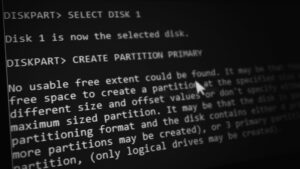Fix: No Usable Free Extent Could be Found
The error ‘No usable free extent could be found’ pops up when you are trying to create a partition using the DiskPart utility. This could if the disk on which you are trying to create a partition isn’t being recognized by the Windows or insufficient space on the drive as the error message suggests. The DiskPart utility, previously known as fdisk, is a command-line interface that lets you partition your hard drive. However, the errors prompted within the utility are often hard to deal with as, like we mentioned above, it is a command-line interface and doesn’t come with that GUI that we are accustomed to.

Nonetheless, don’t worry as in this article, we are going to go through the causes of the issue and later on mention some solutions that you can apply to, hopefully, isolate your issue.
What causes the “No Usable Free Extent could be Found” Error?
Well, the possible causes of the error message are pretty clear as they are mentioned in the error message itself. There are:
- Insufficient Space: Well, this error can occur as there might not be enough space on the disk that you want to create partition on. In such a case, what you can do is check the available space on the drive and then create a partition accordingly.
- Unrecognized Disk: Another cause of this error might be that Windows is not able to recognize the disk properly meaning that Windows can’t write to the device that you are trying to create partition on. A quick fix would be to just insert the disk again but if that doesn’t work, look into the solutions given down below.
Now that we are done with the causes of the issue, let us get into the possible solutions because no matter what the cause is, this error can be really annoying.
Solution 1: Uninstall the device driver from Device Manager (For USB Sticks)
If you are using a USB stick, it is likely that the Windows might not be able to interact with it properly because of a driver issue or Windows hasn’t recognized the device which is very likely to happen in the case of a USB stick. In order to fix that, do the following:
- Right click on My Computer shortcut on the Desktop and click on Properties.
- Once the window opens, click on Device Manager which will be located on the right-hand side.
- Expand the ‘Universal Serial Bus controllers’ category and search for your USB stick.
- Afterward, right-click on it and select Properties. Once in the properties window, switch to the Driver tab and then click the “Uninstall Device” button.

USB Driver Properties - Finally, unplug your USB stick and plug it again.
Hopefully, this would fix your problem of partitioning USB with diskpart and will get rid of this error.
Solution 2: Use a different Partitioning Tool other than DiskPart
There are other partitioning tools which are in fact more user-friendly (Graphical User Interface) and are better than Diskpart. One such tool is MiniTool Partition Wizard. You can use that tool in order to format, create, or resize a partition in Windows.
Solution 3: Run DiskPart using Administrator Privileges
Another thing that you can try is running the DiskPart utility using administrator access. By default, you run the utility using normal privileges and not administrative privileges. Thus, you can try to run it as an administrator and see if that works out. To do that, follow the given instructions:
- Open Start Menu and type cmd. When you see the cmd icon, right click on it and click on “Run as Administrator”.
- Afterward, run diskpart by typing diskpart in command prompt which should open it as an administrator.

Admin CMD – DiskPart
If your issue is caused by not running diskpart with enough privileges, then this would fix it.
Solution 4: Clean the Disk using DiskPart
Though, by doing this, your data might be deleted so you should try it only on a USB disk or on a device where you don’t care about your data or have data already backed up. Here’s how to clean your disk:
- Open up diskpart.
- Once done, select the device you are dealing with by typing select [device number] without the brackets. It’s usually 1 or 0 (If you don’t have a bulk of devices attached).
- Finally, type clean to clean your disk.

Cleaning Disk using DiskPart - After that create the partition on the disk. So, for example if you want to create a ntfs primary partition, type in these two commands:
create partition primary format fs=ntfs quick
Note: You can remove the quick bit from it if you are not in a hurry. Also, to make a fat32 partition instead, just replace the ntfs with fat32.




